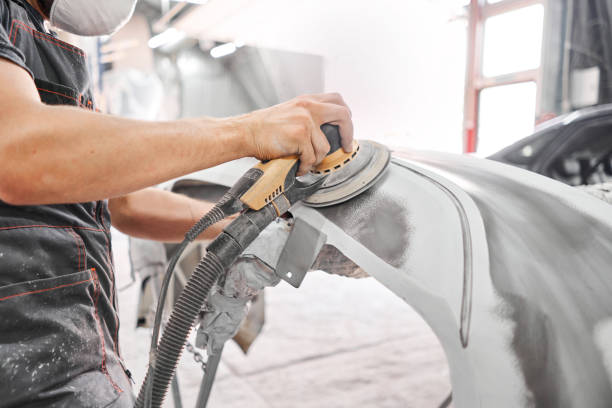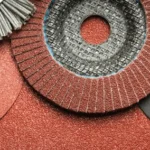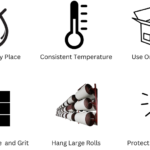
Abrasives are vital tools in many industries, but perhaps nowhere are they more essential than in the automotive sector. From the initial stages of vehicle manufacturing to the final touches in a body shop, abrasives play a crucial role in ensuring that every vehicle looks and performs its best. Understanding the role of abrasives in the automotive industry is essential for anyone involved in car manufacturing, maintenance, or restoration. In this comprehensive guide, we will explore the different types of automotive abrasives, their applications, and how they contribute to the overall quality and performance of vehicles.
At M/s Sandpaper Rodiez, we specialize in providing high-quality, customized abrasives that meet the specific needs of the automotive industry. Whether you’re working on a major manufacturing project or a detailed car restoration, our range of car finishing abrasives can help you achieve professional results every time.
1. Introduction to Abrasives in the Automotive Industry
The automotive industry relies heavily on abrasives for various processes, including surface preparation, finishing, and polishing. These processes are critical for ensuring that vehicles not only look aesthetically pleasing but also meet stringent performance and safety standards.
1.1 What Are Automotive Abrasives?
Automotive abrasives are specialized materials designed to wear down, smooth, or shape surfaces through friction. They are used in a variety of forms, including sandpaper, grinding wheels, and polishing pads. The effectiveness of an abrasive depends on its grit size, material composition, and bonding agent, all of which are selected based on the specific application.
1.2 The Importance of Quality in Automotive Abrasives
In the automotive industry, the quality of abrasives can make a significant difference in the outcome of a project. High-quality abrasives ensure a smoother finish, reduce the risk of surface damage, and improve the overall efficiency of the process. At M/s Sandpaper Rodiez, we import the finest abrasives from around the world and customize them to meet the unique requirements of our clients in the automotive sector.
2. Types of Abrasives Used in the Automotive Industry
The automotive industry utilizes a wide range of abrasives, each designed for specific applications. Understanding the different types of abrasives and their uses is crucial for selecting the right product for your project.
2.1 Coated Abrasives
Coated abrasives are one of the most commonly used types in the automotive industry. They consist of abrasive grains bonded to a flexible backing material, such as paper, cloth, or film. Coated abrasives are versatile and can be used for various applications, including sanding, grinding, and polishing.
- Sandpaper: Sandpaper is a staple in automotive finishing, used for tasks ranging from removing old paint to smoothing surfaces before painting. The grit size of sandpaper can vary widely, allowing for both coarse material removal and fine finishing.
- Abrasive Rolls: Abrasive rolls are similar to sandpaper but come in larger, continuous sheets that can be cut to size. They are ideal for large-scale sanding tasks and can be used with hand tools or power sanders.
2.2 Bonded Abrasives
Bonded abrasives are made by combining abrasive grains with a bonding agent, forming a solid, rigid structure. These abrasives are used for heavy-duty tasks, such as grinding and cutting.
- Grinding Wheels: Grinding wheels are used in the automotive industry for tasks such as shaping metal parts and removing excess material. They come in a range of shapes and sizes, tailored to suit specific applications.
- Cut-Off Wheels: Cut-off wheels are a type of bonded abrasive used for cutting through metal, such as exhaust pipes or body panels. They provide clean, precise cuts and are essential for many automotive repair and manufacturing processes.
2.3 Non-Woven Abrasives
Non-woven abrasives are made from a web of synthetic fibers bonded with abrasive grains. These abrasives are known for their flexibility and are used for applications where surface contouring and finishing are required.
- Abrasive Pads: Abrasive pads are commonly used for surface preparation, such as removing rust or old paint. They conform to the shape of the surface, making them ideal for detailed work.
- Polishing Pads: Polishing pads are used for the final stages of finishing, helping to achieve a smooth, glossy surface. They are often used in conjunction with polishing compounds to enhance the finish.
3. Applications of Abrasives in Automotive Manufacturing and Repair
Abrasives play a critical role in both the manufacturing and repair of vehicles. Their applications are diverse, ranging from initial surface preparation to the final stages of finishing.
3.1 Surface Preparation
Before any painting or coating process, it is essential to prepare the surface to ensure proper adhesion and a smooth finish. Abrasives are used to clean, smooth, and even out surfaces, removing any imperfections that could affect the final result.
- Rust Removal: Rust can be a significant issue in automotive repair, particularly in older vehicles. Abrasive tools, such as sandpaper and abrasive pads, are used to remove rust and prepare the surface for painting or sealing.
- Paint Stripping: When repainting a vehicle, it is often necessary to remove the old paint. Coarse grit abrasives are used to strip away layers of paint, providing a clean surface for the new coat.
3.2 Shaping and Grinding
During the manufacturing process, metal parts often need to be shaped and ground to precise specifications. Bonded abrasives, such as grinding wheels, are used to shape metal components, ensuring they meet the necessary dimensions and tolerances.
- Shaping Metal Parts: Abrasives are used to grind and shape metal parts, such as engine components, ensuring they fit together correctly and function as intended.
- Deburring: After cutting or shaping metal parts, abrasive tools are used to remove sharp edges or burrs, making the parts safe to handle and ready for assembly.
3.3 Finishing and Polishing
The finishing process is critical for both the appearance and performance of a vehicle. Abrasives are used to achieve a smooth, glossy finish that enhances the vehicle’s aesthetic appeal and protects the underlying material.
- Sanding Primed Surfaces: After priming, surfaces are often sanded with fine grit abrasives to ensure a smooth base for the final coat of paint.
- Polishing: Polishing abrasives are used in the final stages of finishing to create a mirror-like shine on painted surfaces. This step is essential for achieving a high-quality, professional finish.
4. The Role of Abrasives in Car Finishing
Car finishing is one of the most critical stages in the automotive manufacturing and repair process. The quality of the finish can significantly impact the vehicle’s appearance, resale value, and protection against environmental factors.
4.1 Achieving a Flawless Paint Job
A flawless paint job is the hallmark of a well-finished vehicle. Abrasives play a crucial role in every step of the painting process, from surface preparation to final polishing.
- Sanding Between Coats: Sanding between coats of paint or clear coat is essential for achieving a smooth, even finish. Fine grit abrasives are used to remove any imperfections and ensure that each layer adheres properly.
- Final Polishing: After the final coat of paint is applied, polishing abrasives are used to remove any minor surface defects and create a high-gloss finish. This step is often performed with polishing pads and compounds to enhance the depth and clarity of the paint.
4.2 Protecting Against Environmental Factors
Abrasives also play a role in protecting vehicles against environmental factors, such as UV radiation, moisture, and road debris. By ensuring a smooth, well-finished surface, abrasives help create a protective barrier that extends the life of the paint and underlying materials.
- Clear Coat Sanding: The clear coat is the final layer of protection for a vehicle’s paint job. Abrasives are used to smooth and refine the clear coat, ensuring it provides maximum protection against environmental damage.
- Underbody Protection: Abrasives are also used in the preparation of underbody coatings, which protect against corrosion and damage from road debris. Ensuring the surface is properly prepared allows the protective coating to adhere effectively and provide long-lasting protection.
5. The Advantages of Using Customized Abrasives in the Automotive Industry
While standard abrasives are widely available, customized abrasives offer several advantages that can enhance the quality and efficiency of automotive work. At M/s Sandpaper Rodiez, we specialize in providing customized abrasive solutions that are tailored to the specific needs of our clients.
5.1 Precision and Consistency
Customized abrasives are designed to meet the exact specifications of a project, ensuring precise and consistent results. This precision is especially important in the automotive industry, where even minor imperfections can impact the overall quality of the work.
5.2 Increased Efficiency
By using abrasives that are specifically tailored to the material and application, you can achieve the desired results more quickly and with less effort. This increased efficiency can reduce labor costs and improve turnaround times, making customized abrasives a cost-effective choice for professionals.
5.3 Enhanced Durability
Customized abrasives are often more durable than standard options, as they are designed to withstand the specific demands of the task. This durability means that they last longer and require fewer replacements, further reducing costs and downtime.
6. Expert Tips for Using Automotive Abrasives
Even the best abrasives require proper technique and care to achieve the best results. Here are some expert tips to help you get the most out of your automotive abrasives:
6.1 Use the Right Grit for the Job
Choosing the appropriate grit size is crucial for achieving the desired surface quality. Coarse grits are suitable for material removal and shaping, while finer grits are ideal for finishing and polishing. For automotive applications, it’s important to follow a progressive approach, starting with a coarser grit and gradually moving to finer grits to achieve a smooth, even surface.
6.2 Maintain Consistent Pressure
Applying consistent pressure when using abrasives ensures even material removal and a uniform finish. Excessive pressure can lead to uneven surfaces, premature wear of the abrasive, and potential damage to the workpiece. Practice using a steady hand to maintain control and achieve professional results.
6.3 Keep Abrasives Clean and in Good Condition
Abrasives can become clogged with material during use, reducing their effectiveness. Regularly clean your abrasives by tapping them gently to remove debris or using a dedicated cleaning tool. Proper storage is also crucial—keep abrasives in a dry, cool environment to prevent moisture damage and ensure they remain effective for longer periods.
6.4 Match the Abrasive to the Tool
Different tools and machines require specific types of abrasives to function optimally. For example, a random orbital sander works best with hook-and-loop sanding discs, while a belt sander requires continuous sanding belts. Using the correct abrasive for your tool ensures better performance and prolongs the life of both the tool and the abrasive.
6.5 Follow Safety Guidelines
When working with abrasives, always follow safety guidelines to protect yourself and ensure the best results. Wear appropriate personal protective equipment (PPE), such as gloves, safety glasses, and dust masks, to prevent injuries from flying debris or dust inhalation. Additionally, ensure that your work area is well-ventilated and free of flammable materials.
7. Conclusion: The Critical Role of Abrasives in Automotive Excellence
Abrasives are indispensable in the automotive industry, playing a key role in everything from manufacturing to restoration. High-quality automotive abrasives not only improve the efficiency and quality of your work but also contribute to the durability and aesthetic appeal of the finished product.
By investing in premium abrasives and using them with the right techniques, you can achieve professional-level results that stand out. Whether you’re a large-scale manufacturer or an individual restorer, understanding the role of abrasives in automotive applications is essential for delivering top-tier workmanship.
At M/s Sandpaper Rodiez, we are committed to providing the automotive industry with the highest quality customized abrasives. Our products are designed to meet the specific needs of each project, ensuring that you have the right tools to achieve exceptional results. Explore our range of automotive abrasives on our website, https://sandpaperrodiez.com/, and discover how we can help you elevate your work to new levels of precision and excellence.



